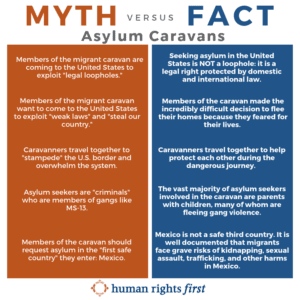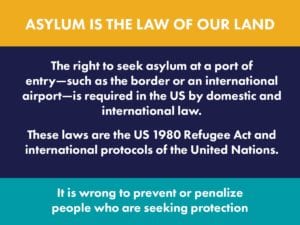Real Needs, Not Fictitious Crisis Account
for the Situation at the US-Mexico Border
Recommendations of Justice for Immigrants
for the Biden Administration
Over the past couple of months, Justice for Immigrants (JFI) Core Members have collaborated on a series of documents that represent the collective recommendations of JFI for the incoming Biden Administration and 117th Congress. The documents, divided into four different areas, are:
Ensuring-Access-to-Lawful-Status-and-Citizenship: Addresses both those already living in the U.S., such as Dreamers and TPS holders, and those seeking to migrate, such as refugees, while also emphasizing the importance of family unity and treating all migrants with dignity, regardless of income, race, or religion.
Guaranteeing-Just-and-Humane-Border-Policies: Focuses on the situation at the U.S.-Mexico border, including policies such as the Migrant Protection Protocols (MPP), and highlights the need for reform in order to cultivate a more humane approach to border management and ensure due process.
Reforming-Enforcement-and-Ending-Mass-Detention: Critiques current detention and deportation policies, especially their use as a deterrent to migration, and proposes solutions for reforming the system, including the increased use of meaningful community-based alternatives to detention (ATDs) and ensuring protections for vulnerable populations.
Addressing-Root-Causes-of-Migration-from-Central-America: Identifies challenges in U.S. foreign policy, international assistance, and trade, and advocates for approaches to these issues that further the common good and recognize the right to a dignified life for all people.
A page has also been created on the JFI website for these documents.
How should these documents be utilized?
Familiarize yourself with each document:
Read through each document;
Highlight the issues with which you are familiar; and
Increase your understanding of those issues you don’t know as much about.
Tune in to the JFI national call, where these documents will be discussed in more detail: JFI National Call – Wed., January 13, 2021 at 2 PM Eastern
Share the documents with fellow advocates and those seeking to learn more about JFI’s goals for improving U.S. immigration law and policy.
Engage with legislators:
Be prepared to engage with your lawmakers on the JFI recommendations.
Immigration Plan 2021
(Restoring Human Dignity
Recovering the Economy
Reinforcing American Values)
The Immigration 2021 Plan has been in development for months and now over 170 immigration and advocacy organizations have endorsed this blueprint for the next administration to restore human dignity to a system weaponized by the current administration, reinforce core American values, and power the economic recovery of the nation. “While the 2021 Immigration Action Plan seeks to undo the damage wrought by the Trump administration—from putting children and families in cages and restricting the due process rights of immigrants at the border, to extending the detention limit for children and families, and forging ahead with a failed border wall—it acknowledges that more must be done to truly transform the system. Trump’s divisive, anti-Black and racist rhetoric against immigrants fans the flames of xenophobia, further corroding a system that has been broken for decades. Re-envisioning the country’s immigration system to work in the long term will take a coordinated, clear-eyed effort that aims to benefit immigrant families in every policy initiative.” (Advocacy for Human Rights in the Americas) Read the Immigration+Action+Plan 2021.
Seeking Refuge
Global Sisters Report brings a sharper focus to the plight of refugees through this special series which follows the journeys refugees make.
Seeking Refuge E-Book
Pope Francis calls Trump’s border policy ‘cruel,’
compares southern barriers to Berlin Wall
Because of the US government’s response to the migrant caravan, it is important that we understand the the difference between migrants and refugees and that there are laws, both internationally and nationally to protect refugees.


You might want to read an article from a recent America magazine and/or the article by WOLA (Washington Office on Latin America):
One of our concerns is protection of the rights of immigrants within our country. Below are documents both in English and Spanish outlining steps parents can take now to protect their children in case of immigration enforcement:


